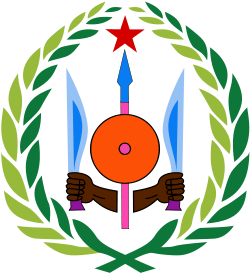Health in Djibouti
In Djibouti, malnutrition is severe and the incidence of Tuberculosis is high. Malaria is low.
Health care
In 2010 there were an estimated 23 physicians and 80 nurses per 100,000 people.[1] Since healthcare in the region is so poor, more than a third of the healthcare recipients are migrants. Healthcare is best in the capital; outside the capital it is limited by poor infrastructure, equipment shortages, and a lack of qualified personnel.[2]
Life, maternal, death, and birth rates
Life expectancy has increased by 18 years since 1960.
| Year | Male | Female | Total |
|---|---|---|---|
| 1960 | 42.7 | 45.4 | 44.0 |
| 1970 | 47.8 | 50.6 | 49.1 |
| 1980 | 52.1 | 55.2 | 53.6 |
| 1990 | 55.1 | 58.3 | 56.7 |
| 2000 | 55.5 | 58.6 | 57.0 |
| 2010 | 58.9 | 61.9 | 60.4 |
| 2014 | 60.4 | 63.7 | 62.0 |
Infant mortality has decreased by 38.5 deaths per 1,000 live births since 1990.
| Year | Male | Female | Total |
|---|---|---|---|
| 1990 | 100.6 | 84.4 | 92.7 |
| 2000 | 86.5 | 72.6 | 79.7 |
| 2010 | 67.7 | 56.3 | 62.2 |
| 2015 | 59.2 | 49.1 | 54.2 |
Djibouti's birth rate is 23.6/1,000 inhabitants, while its death rate is 7.6 deaths/1,000 inhabitants. The maternal rate is 2.29 deaths/1,000 inhabitants.[2] The death rate was 7.73 deaths per 1,000 inhabitants.[1]
HIV/AIDS
The HIV/AIDS in Djibouti prevalence was 1.6% of the population for those aged 15–49 years old, as of 2015.[1] As of 2015, there were approximately 9,400 people living with HIV/AIDS in the country.[2] There were an estimated 600 deaths from AIDS in 2015.[2]
Women and children
There were 1,007 cases of malaria in 1994. Between the mid-1970s and the mid-1990s, 23 percent of children under five were underweight. That number has risen to 29.8% in 2012.[2] In Djibouti, 93.1% females had female genital mutilation as of 2006.[1] Female genital mutilation is a leading cause of infant and maternal mortality, and it continues to be prevalent to this day, despite a 1995 law prohibiting the practice.[2]
Notes
![]() This article incorporates public domain material from the Library of Congress Country Studies website http://lcweb2.loc.gov/frd/cs/.
This article incorporates public domain material from the Library of Congress Country Studies website http://lcweb2.loc.gov/frd/cs/.
